Historical
ASTM D2937-10
Standard Test Method for Density of Soil in Place by the Drive-Cylinder Method
1.1 This test method covers the determination of in-place density of soil by the drive-cylinder method. The test method involves obtaining a relatively intact soil sample by driving a thin-walled cylinder and the subsequent activities for the determination of in-place density. When sampling or in-place density is required at depth, Test Method D1587 should be used.
1.2 This test method is not appropriate for sampling organic soils which can compress upon sampling, very hard natural soils and heavily compacted soils which cannot be easily penetrated by the drive sampler, soils of low plasticity which will not be readily retained in the cylinder, or soils which contain appreciable amounts of gravel (particles coarser than 4.75 mm (3/16 in.)). The presence of particles coarser than 4.75 mm (3/16 in.) may introduce significant errors in density measurements by causing voids along the wall of the cylinder during driving, and when coarse materials have to be dislodged by the trimming of the sample obtained by the cylinder.
1.3 This test method is limited to the procedures necessary for obtaining specimens suitable for determining the in-place density and water content of certain soils. The procedures and precautions necessary for selecting locations and obtaining intact samples suitable for laboratory testing or otherwise determining engineering properties is beyond the scope of this test method.
1.4 The values stated in SI units are to be regarded as standard. The inch-pound units given in parentheses are mathematical conversions, which are provided for information purposes only and are not considered standard.
1.4.1 It is common practice in the engineering/construction profession to concurrently use pounds to represent both a unit of mass (lbm) and a unit of force (lbf). This implicitly combines two separate systems of units; that is, the absolute system and the gravitational system. It is scientifically undesirable to combine the use of two separate sets of inch-pound units within a single standard. As stated, this standard includes the gravitational system of inch-pound units and does not use/present the slug unit for mass. However, the use of balances or scales recording pounds of mass (lbm) or the recording of density in lbm/ft3 shall not be regarded as nonconformance with this standard.
1.5 All observed and calculated values shall conform to the guidelines for significant digits and rounding established in Practice D6026, unless superseded by this standard.
1.5.1 The procedures used to specify how data are collected/recorded or calculated in this standard are regarded as the industry standard. In addition, they are representative of the significant digits that generally should be retained. The procedures used do not consider material variation, purpose for obtaining the data, special purpose studies, or any considerations for the user's objectives; and it is common practice to increase or reduce significant digits of reported data to be commensurate with these considerations. It is beyond the scope of this standard to consider significant digits used in analysis methods for engineering design.
1.6 This standard does not purport to address all of the safety concerns, if any, associated with its use. It is the responsibility of the user of this standard to establish appropriate safety and health practices and determine the applicability of regulatory limitations prior to use.
Content Provider
ASTM International [astm]






